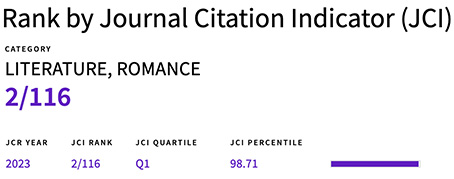Author Guidelines
To submit a paper proposal, authors must register as users of the journal. With your username and password, you will be able to access the uploading platform that will guide you step by step in the process. The submission of a paper has no APC.
The originals will be submitted through OJS platform on computer support (OpenOffice, Microsoft Word, RTF or WordPerfect). The platform will guide the author through the process and it will inform him/her of the fields to fill in (personal data, title, summary, keywords, etc.). We recommend reading this Author's Guide to OJS before submitting.
Although the OJS platform has its own fields for this information, all original articles or notes must be preceded by title, abstract and keywords in Spanish and English, regardless of the language in which they are written. In the case of reviews, this information can be ignored.
The document uploaded to the platform must be anonymous, that is, it does not explicitly indicates the author and it is not possible to know who the author of the document is by consulting its properties. More information on this in Ensuring an anonymous evaluation.
Likewise, the document uploaded to the platform will have as few formatting elements as possible. These should be limited to the most conventional ones: italics for titles, foreign terms and emphasis; long citations (more than three lines) indented, footnotes (not at the end of the document) and justified paragraphs with a line spacing equal to or greater than 1.5, in order to make easier readings for the reviewers. Our layout designers will be in charge of giving the final format to the article.
If the work includes illustrations, tables or diagrams of any kind, in addition to their place in the article, they must be attached separately in the corresponding section of the OJS form with a minimum quality of 100 dpi (web presentation quality) and in. JPG, .GIF or .PNG.
Referencing Style
Celestinesca does not require adherence to a specific bibliographic standard, but does require the use of a regularized citation system (for example, MLA or APA). Regardless of whether the chosen citation system requires it or not, in the final bibliography it will be essential to include the digital identifiers of the electronic resources used (DOIs, URIs or permanent links). If the resource does not have a digital identifier (in the case of PDFs of publications without individualized presentation of each file or on platforms such as Academia.edu), the web address will not be included.
Works with a non-regularized quoting system will not be accepted. When in doubt, the following fereferencing system is recommended:
a) With a footnote, quoting books and articles as follows:
Book:
James J. Murphy, La retórica en la Edad Media. Historia de la teoría de la retórica desde San Agustín hasta el Renacimiento [1974], Madrid, Fondo de Cultura Económica, 1986.
Book with a digital identifier:
E. Michael Gerli, «Celestina» and the Ends of Desire, Toronto, University of Toronto Press, 2011. https://doi.org/10.3138/9781442694286
Journal article:
J. T. Snow, «Celestina (1499-1999) Medieval and Modern: Survival & Renewal of a Spanish Classic», Medieval Perspectives, 15 (2000), pp. 1-11.
Journal article with a digital identifier:
Francisco Ynduráin, «Una nota a La Celestina», Revista De Filología Española, 38, 1/4 (1954), pp. 278–281. https://doi.org/10.3989/rfe.1954.v38.i1/4.1093
Book chapter:
Alan Deyermond, «La Celestina como cancionero», in Cinco siglos de «Celestina»: aportaciones interpretativas, eds. Rafael Beltrán and José Luis Canet, Col.lecció Oberta, València, Universitat de València, 1997, pp. 91-105.
Book chapter with a digital identifier:
José Luis Canet, «The Early Editions and the Authorship of Celestina», in A Companion to «Celestina», ed. Enrique Fernández, Leiden, Brill, 2017, pp. 19-401. https://doi.org/10.1163/9789004349322_003
Unpublished dissertation (or some other kind of unpublished academic writing):
Fernando Carmona Ruiz, La recepción de «La Celestina» en Alemania en el siglo XVI, Fribourg, Université de Fribourg, 2007 [unpublished doctoral thesis]. http://doc.rero.ch/record/8753
b) In-text citing, quoting books and articles as follows:
In parentheses:
(Murphy 1986: 128-129; Deyermond 1997: 95).
Combined with the text:
[...] según las observaciones de Deyermond (1997: 96), [...]
Cited works
In both cases, a cited works list will be included at the end of the article.
If referencing style a) has been used, that is, citing with footnotes, the bibliographic references included in the footnotes will reappear in alphabetical order (by surname). With this purpose, the surname(s) will be written in the first place, separated from the first name by a comma.
Example:
Murphy, James J., La retórica en la Edad Media. Historia de la teoría de la retórica desde San Agustín hasta el Renacimiento [1974], Madrid, Fondo de Cultura Económica, 1986.
Example:
Ynduráin, Francisco, «Una nota a La Celestina», Revista De Filología Española, 38, 1/4 (1954), pp. 278–281. https://doi.org/10.3989/rfe.1954.v38.i1/4.1093
If referencing style b) has been used, that is, in-text citing, the cited works list will be presented in alphabetical order (by surname). With this purpose, the surname(s) will be written in the first place, separated from the first name by a comma, and followed by the publication year between parentheses.
Example:
Murphy, James J. (1986), La retórica en la Edad Media. Historia de la teoría de la retórica desde San Agustín hasta el Renacimiento [1974], Madrid, Fondo de Cultura Económica.
Example:
Ynduráin, Francisco (1954), «Una nota a La Celestina», Revista De Filología Española, 38, 1/4, pp. 278–281. https://doi.org/10.3989/rfe.1954.v38.i1/4.1093
Please note that the only difference between both referencing systems is where the publication year appears: immediately after the author in the referencing system b), to make locating references easier; at the end of the bibliographic entry in the referencing system a), because it is not necessary for locating the reference.




